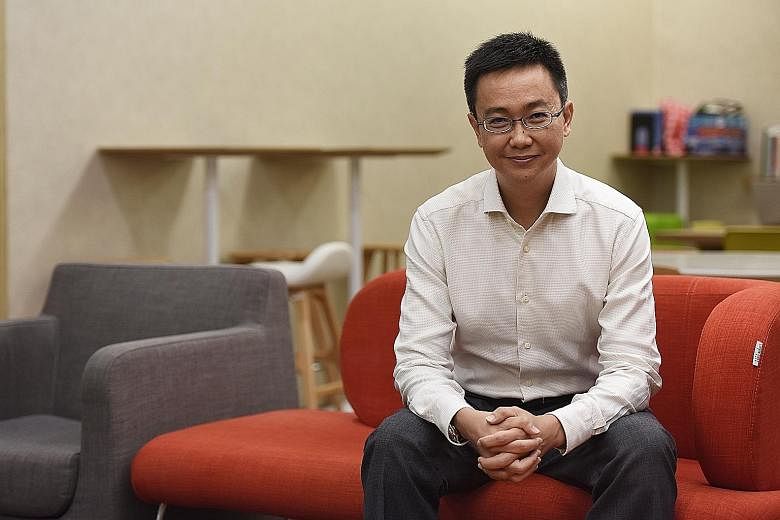While mega childcare centres in standalone buildings are being set up to help meet growing pre-school demand, the Government has also been making advance plans over the past year for larger centres in upcoming Housing Board blocks.
This includes centres offering 200 places - double the number offered by most of those in HDB blocks now. The actual capacity will vary from project to project and could be fewer than 200, depending on the project scale and other space and design considerations. "Nevertheless, they will be, on average, larger than recently completed centres," said Early Childhood Development Agency (ECDA) chief executive Eugene Leong, 41, in his first media interview since taking on the role in 2015.
The former senior director for strategic planning at the Ministry of National Development told The Straits Times: "In the past, it used to be more opportunistic. If there's an empty void deck space, then we use it. Now we're pre-designing it." This involves ECDA and HDB understanding each other's design needs and factoring them into HDB plans for new Build-To-Order projects.
His remarks came weeks after it was announced that four more mega childcare centres run by government-appointed anchor operators will open by the middle of next year, bringing the total number of such centres to nine.
Anchor operators get government grants and priority in securing HDB sites, but have to meet fee caps and quality criteria.
Mr Leong assured parents that large centres still have to adhere to staff-child and space-child ratio requirements. "A large-capacity centre does not imply a larger class, but more classes at the same level, to cater to more young families."
-
Pre-school: 'Three years is enough'
-
A common misperception among parents is that children should be enrolled in pre-school as infants.
They might think that, since it is about development, they should put their children in infant care to ensure a good start in life, said Early Childhood Development Agency chief executive Eugene Leong. However, he noted: "The best teacher is still the parent in most circumstances."
He made this point during a recent exclusive interview with The Straits Times.
"Research suggests that, in terms of school-readiness, about three years of pre-school would be adequate. This presumes the children have an appropriate home environment with an available and trusted caregiver in their earlier years," he said.
"If the parents are available, and have the time and capacity to raise the child, then the child doesn't have to be enrolled too early."
Still, he said his agency is aware that some parents might need to enrol their children earlier if they are working and do not have other care arrangements.
Children from disadvantaged backgrounds could also gain from earlier enrolment, he said, noting initiatives taken to help this group, such as KidStart, a three-year pilot scheme started in July last year.
"Our efforts in recent years have been directed at providing accessible, affordable and quality pre-schools to support parents, enable women to stay in the workforce after childbirth and ensure holistic development of children beyond school-readiness," he said.
"Working parents can be - and many of them are - involved parents."
He said the authorities had been encouraging a stronger relationship between parents and pre-schools. This would help identify children's needs earlier, give parents greater assurance and reduce teachers' stress when dealing with parents.
Speaking about his personal experience as a father of three children, aged six to 13, Mr Leong said: "(My wife and I) got quite involved in their pre-schools, supporting the concerts and graduation events, and that allowed us to bond with the teachers.
"That also rubs off on the kids as they know there is a good relationship between the parents and teachers."
Priscilla Goy
Parents will also still be able to choose between pre-schools of different capacities and the mega centres will not be the norm, he said.
"Even if a centre has the best teachers, it may not necessarily be suitable. It might be too big a school. Maybe the child is more comfortable with a smaller setting," he said.
"Even today, with our large centres, parents have choices. There's still going to be a range. The large centres are not the main source of supply for childcare. It's going to be the usual smaller centres."
The authorities have expanded existing void deck centres where there is demand and space available. A My First Skool in Yishun had close to 200 more places after building extension bays twice, and now spans four blocks near one another.
Executive principal Zethy Dzarifah said operations have "largely remained the same", though she had to be careful to ensure adequate labour across all bays at all times.
Mr Leong said about half the more than 1,300 childcare centres here are in HDB void decks and they help to meet parents' need for convenient locations.
Medical social worker Nicholas Lo, 38, who has a daughter enrolled in a childcare centre in a void deck, said such centres "offer more convenience to parents".
"I think more childcare and eldercare centres in void decks should be set up, rather than mega childcare centres. Then we can take our elderly parents who need day care and young children to the same area."


